Status of research on brainwave reading
After much research, We came to the conclusion that it is not possible to obtain reliable information "watching" the brain from the outside.
It's not about budget, It's about seeing the brain from the outside, then only see the result of the sum of the activities of all neurons of the brain together (with minor differences due to the position of the electrodes – so minimal that much of the time it's just noise or interference from the movement)
Whereby "patient" cannot "think of a pressed key" but I get with a different activity. And press is just a side effect of this intense activity. Basically you must learn to involve the entire brain and sync, in order to increase, for example,, alpha waves compared to Beta. An ordinary person cannot do it right, the best they can do it in a few seconds, but just focusing and standing firm.
A bit like saying: "to press up arrow key-on you must stop breathing until you see the button is pressed, to release it again to breathe and after a few seconds you will release "
Perform actions with the thought ?
To perform actions there are better methods. If budget issue Hawking students (https://it.wikipedia.org/wiki/Stephen_Hawking) they equipped its super processed helmet Chair. But they tried everything and in the end they chose to look eye-movements with a camera.
With a camera, for example,, eye closure you discover very quickly. With the closing of the eyes you can get four bits of information and many more with eye movements, myoelectric impulses, the direction and speed of the breath etc… With these techniques can easily get tens of bits per second while with an EEG, for how expensive, the response times are of many seconds for a single bit.
For Hawking have done just as well, If you look carefully, in all its recent pictures you see a camera hanging eyeglasses (and in some cases even more experimental sensors).
And now Hawking can speak, Surf the internet and even write books. With the thought would never be able to do all these things.
If there was any possibility of using the thought wouldn't have budget problems. The only wheelchair costs as hundreds of MindWave and EmotivEEG and already had lithium batteries when none of us had even heard of.
Can we do better than the MindWave and EmotivEEG ?
Hate to say it, but we can't. Those two devices have been designed with great care and "trying" to obtain the best possible result. Yet the results are more or less confused (When it's good), and completely random (When the subject is not suitable for).
Subject unsuited? Apologies are always the same, you have to train more, It takes more concentration… In practice to press a button you have to relax completely and then focus for a few seconds. What you should do to write a message? Probably ten years of apprenticeship as a Buddhist monk.
Now the electrodes of a certain quality are all non-contact, but the results are always more or less the same: great instability and no security that if worked today will work tomorrow. Even with 24 endings and big devices with a closet have managed to have decent results.
Active electrodes (first version)
The first version, as from previous images, required a particular electrode with Silver tips. We thank Marco Vitali of: www.vitalibruno.com for having prepared a test enclosure in silver (see image). To make contact with the skin can do no better than silver, even gold is better, and toes help to go hair and to firmly hold the electrode.
Unfortunately, testing has shown that even with these electrodes just the slightest movement to create potential differences of the same order of magnitude of EEG signals (100 UV). To avoid this you have to degrease the skin with alcohol and press much with belt. And unfortunately it also happens that after some time the tips, as far as rounded, begin to annoy. In less than one hour you create markers in the skin which then lasts for a long time.
In conclusion, hate to say it, but this road is not reliable enough to be part of the system Theremino.
Active electrodes (non-contact)
Fortunately during rehearsals with the shell shield and silver with high impedance electrodes we discovered that even with a thin insulating layer between electrode and skin useful signals continued to pass by capacity.
We discovered the non-contact detecting EEG and ECG!!!
As usual, however it is difficult to get there first.
Just search “Do not contact electrodes” on Google…
Non-contact electrodes have many advantages, first of all the complete elimination of the galvanic connection with patient, then security to 100% without batteries or complicated power circuits with safety regulations impossible.
Advantages of the electrodes without contact:
- Total security (the patient is electrically isolated)
- Elimination of complicated isolation circuits
- Eliminate the need to go to batteries
- No galvanic contact voltages for which serves the silver
- Being able to use the copper you do everything with multiple layers of printed circuit board
- Better signal even if the patient moves
- “Zero preparation” (You should clean your skin with alcohol)
- No contact tips
- The flat surface and easier to sterilize
- Functioning even through clothing
- Reduced performance you get even a few centimeters away
- Reduced performance you can make fabric electrodes (moistened only by sweat)
First tests of the electrodes with signal generator
Those wishing to experiment with ThereminoEEG version 1.0 Please download it from here:
https://www.theremino.com/downloads/biometry#eeg
To test it you can use a pin set as input proportional Cap16 and move with a finger. If you move fast you can get beyond the 10 Hertz.
Or sooner or later we will start these new tests PCB. The center circle on the right is the electrode that mates with the skin, the ring (and the back face all in copper that is not seen) isolate it from the environment with an active screen that reduces the effective ability to practically zero.
For the first tests we chose an external diameter of 30 mm and the total thickness is below the 5 mm. Are electrodes small enough to fit comfortably in their place them under an elastic band, but at the same time have very 6 cm paintings of active electrode.
The round shape is a major improvement, it becomes much easier to build them mechanically, and then the containers.
Version 2 – compensation capacity
This new version has a more complex compensation circuit, According to the simulations, should improve the functioning even electrodes away from skin. With strong ECG signals you can work even at incredible distances from the skin (10 mm and up to 20 mm with some degradation of bandwidth)
We are doing experiments to determine whether this compensation is actually needed and what are the best values of the components.
– – – – – – – –
Mounting the sensor
First of all keep in mind that we haven't tested so maybe it won't work right. May not work well or not at all for a thousand reasons, could auto-oscillate or collect power frequency interference to the point of being completely useless. Unfortunately the little time we have is leaving everything to the NetHAL and the NetMaster that will work in network and even in WiFi (but not with all kinds of Master Pin and with a single Adc).
The disc that you see on the left is the face that goes toward the skin. The side towards the skin from now we will call “at the bottom”.
Of course the metallic parts must not touch the skin so it will take even a layer of thin plastic sheet.. A thin plastic like the one of the water bottles can fit. The plastic will “deep drawn” to hot to form a DRAM. Alternatively you might find a exact diameter short and very thin plastic.
The central part of the first disk is a sensitive area that needs to be coupled capacitively with the skin and which is terribly sensitive screen, and then goes as far as possible by electric fields at mains frequency coming from the electric system.
So around the sensitive area is called a ring “on call”.
The second disc is the posterior aspect of the first disk and need to screen electrically sensitive zone centrale from components of the third disc that otherwise would pass for ability their signals to record sensitive doing hopelessly autooscillare everything.
Around the first and second holes are metalized disk acting as a Faraday cage and help to shield the little signal that could have come from the sides.
Both the guard ring that the rear face are connected with a small wire which will pass through a hole to be made in silver rectangle “GUARD” the third disc. You connect them to “GUARD” instead of mass because otherwise the ability to ground completely would Dim the signal.
In the next image we see the silver rectangle where you will make the hole where it passes the wire that will be paid to “GUARD” the first disc. And also the rectangle “In” will have a small hole with a small wire that will be paid to “In” the first disc.
We didn't do the holes in plots GUARD and IN the third disk because you thought you mount it with the component side to the first disk and then do double sided with the back completely at the top and connected by copper by holes to its mass. But this Assembly would have made it impossible to do tests. For example,, change a component or solder a tad bit somewhere to make measurements.
Whereby the prototypes (yet to try) We did the third disc to a face alone and assemble with components to high #8217 &; (not to the skin). But be careful with this kind of installation you will have to pay attention to two things:
1) The outer ring of holes are not metallic and then do not touch the outer face of the first disk.
2) That the components will not be left uncovered but you must add a disk “all copper” to shield upwards. This last screen will be paid with a single side wire, so that you can uncover to access components and then close during the functional test.
And finally, at three pitches on the right: SIGNAL, + 5 and GND, settled three soft wire that will go to a Master Pin configured as Adc16.
– – – – – – – –
For those who want to experiment, Here's the project at present (as soon as we have time to improve)
Eagle project downloads + simulations + 3D images
Sensor_NonContact_V2


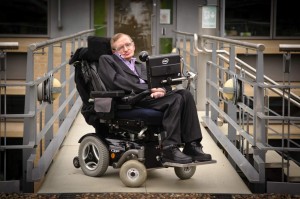
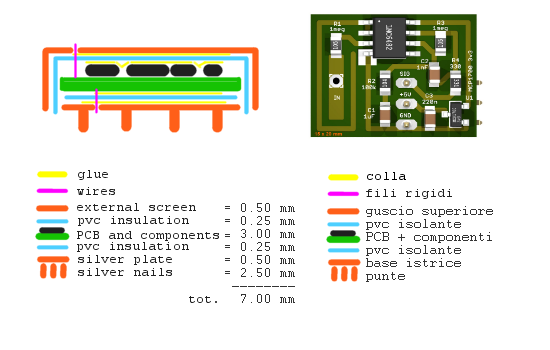
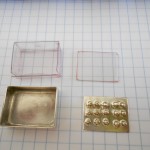
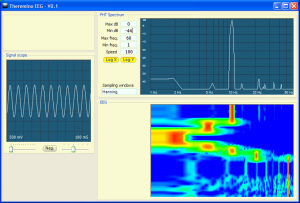
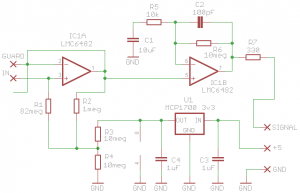
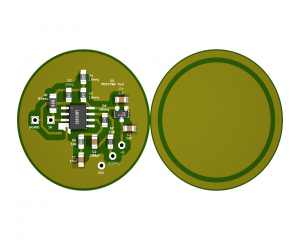
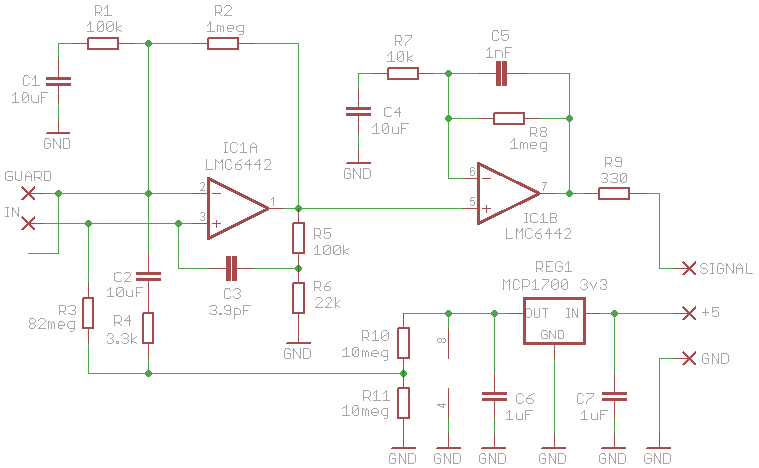
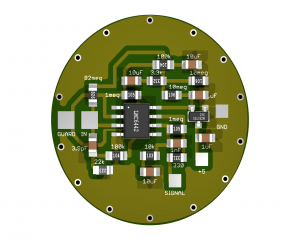
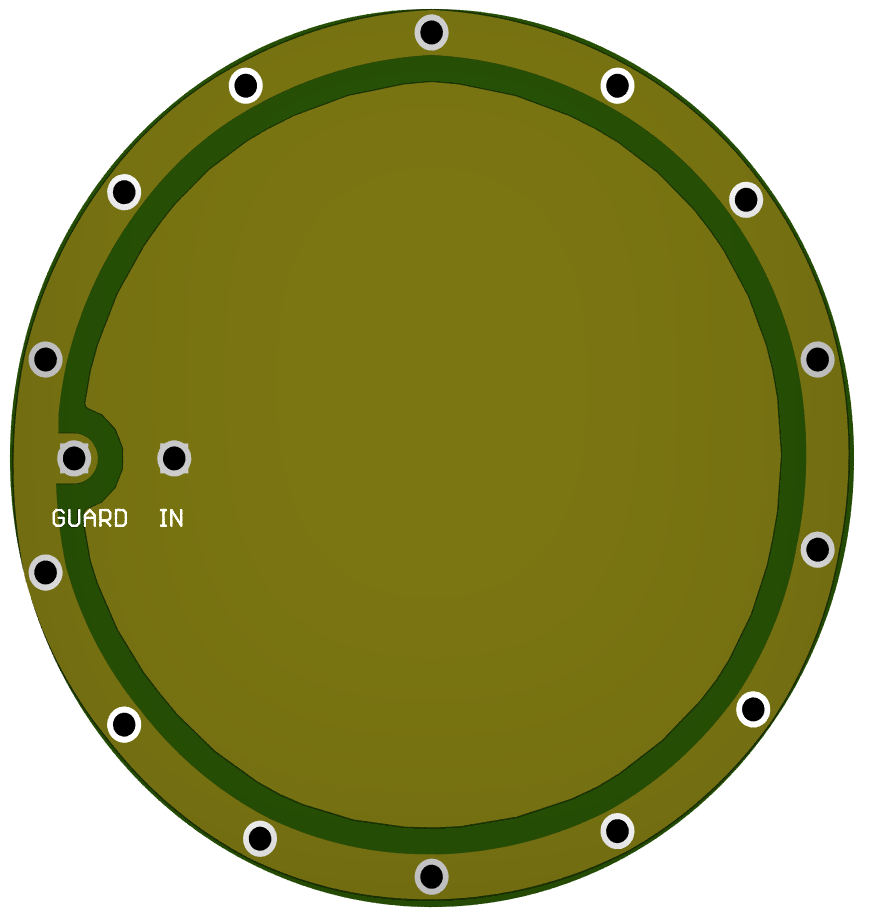
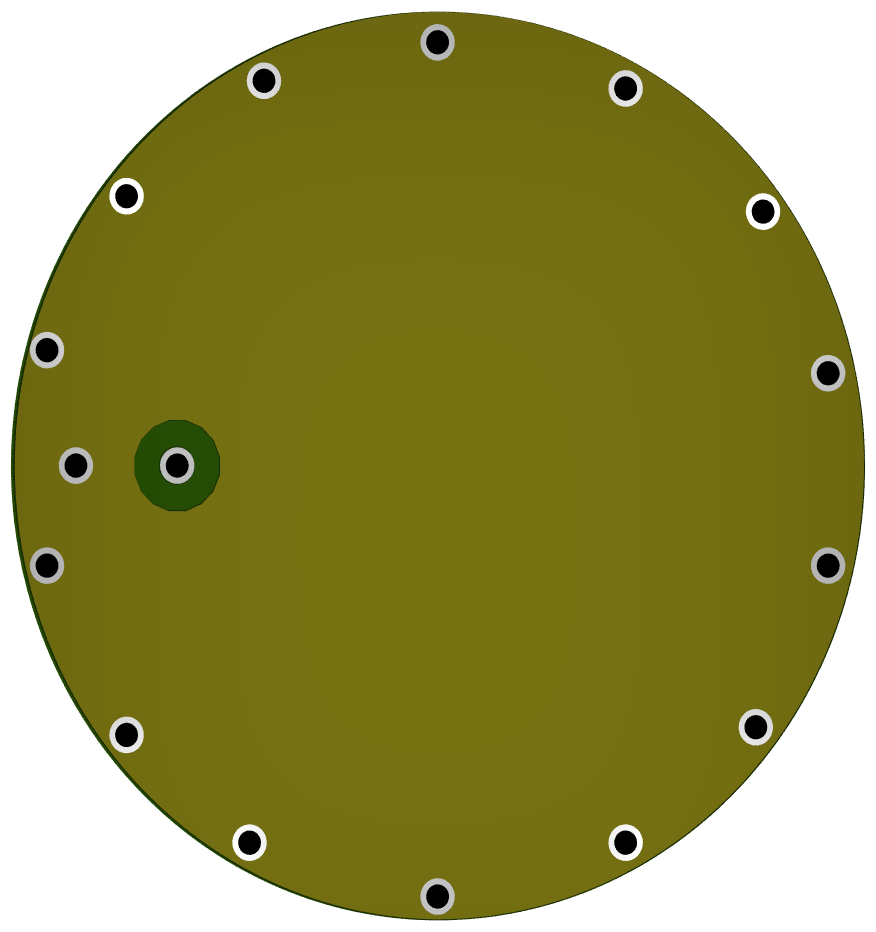
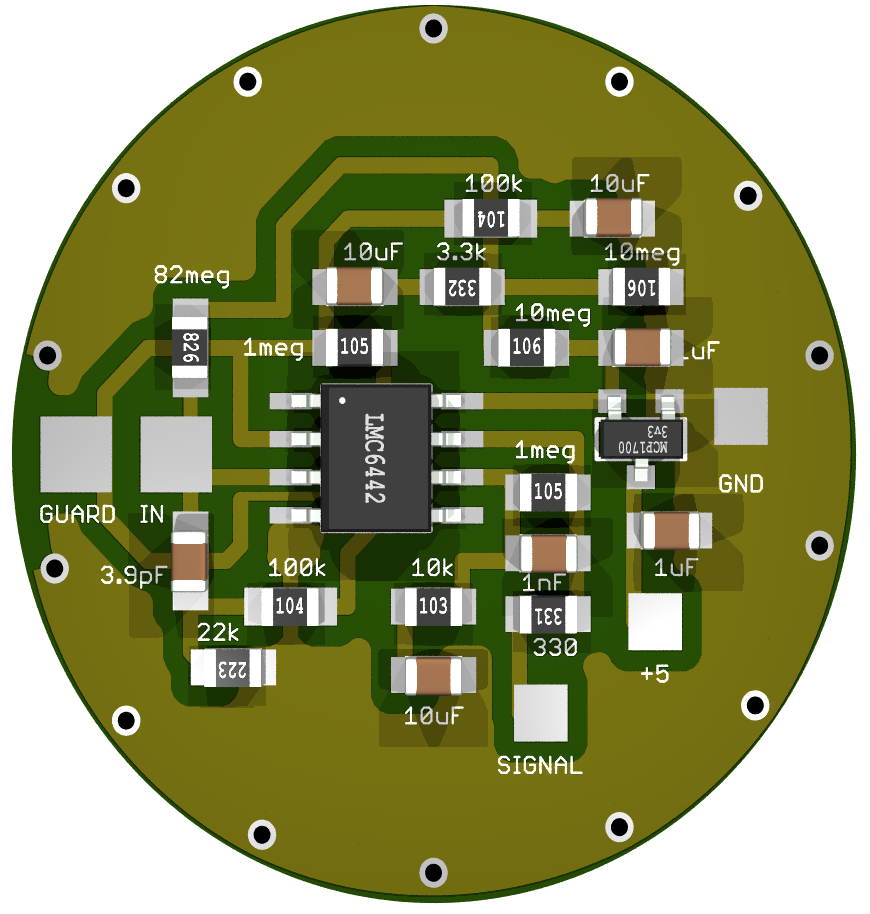
Livio, look at the link I posted above.
There is a new method, without end, using ECG and PPG synchronized.
Unfortunately, It is not cheap.
I watched, but I am convinced that the pressure measurement through optical measurements is very inaccurate. If careful in the article are careful from using the word “accuracy” and use in its place “accuracy”. Accuracy just want to say that on average the measures are centered on the true value, but says nothing about what might be wrong individual measures.
The four images on this page explain it better than I.: https://it.wikipedia.org/wiki/Accuratezza
Obviously, this system is not the ultimate solution.
In general, when a measurement must be done in conjunction with another to reduce the uncertainty, it means that the basic error is high, and the result is usually not the best of precision.
The advantage is not to use the band.
As for the link to the accuracy, I did not know him, and it's really enlightening :)
Salve, my name is’ William and I would be interested in developing this type of
EEG sensor without direct contact with the skin. I know the electronics but are not able to physically implement these sensors. On the other hand I know well the classic via EEG electrodes Ag / gel and Sure recognize if you get a good EEG signal or not, and if the new type and’ more’ or less immune from the typical shortcomings of standard sensors. I made scientific publications using the EEG in research.
So I might try Prototype, if you can’ to interest.
.
I'm sorry but I do not know if and when we dedicate ourselves to the sensor.
Unfortunately, the tests done (years ago) They were not conclusive. Then we had to complete other more urgent projects. To carry out research on these sensors should take very long time and now we do not have.
The operating principle is right but someone should build them and try them. It must also be an electronics expert, because surely there will be to make small adjustments in the component values, and perhaps there will be problems to understand and solve (instability probably caused by parasitic capacitances and the arrangement of components).
Hello, I ask you for help, I saw that no insights in this area….I mean, since there are cheaply meters of negative ions was thinking of letting me if it was feasible. the market is only one kind to about 40E but I do not reliable at all… What I want to know is the principle upon which the measurement…. I think that some amateur did it using the capacitive effect, I do not know if it's right. What can you tell me?Thank you
Surely with a capacitive input, or even with an ADC input, you would have some variation if you get close to an old TV or a negative ion generator.
But see a value that changes a bit’ It's not “measure”. the changes “measured” depend on the type of input that uses, the size of the antenna, by losses and input capacity… etc..
So to really measure should build a device taking into account all these variables. Probably the entrance should be a MOSFET or a FET, and it would take a special resistor by at least one giga ohms to have a known and precise input impedance.
The construction should be treated and cleaned in order to avoid that in the presence of dirt or moisture can change the input impedance (just nothing to change that very high impedance which is necessary to measure the ionisation).
Finally, even if he could design and build a great machine, then this should be calibrated by comparison with a commercial apparatus. And then the comparison device should still buy. Otherwise never would know what you're measuring, and even if your device shoots random numbers or at least look like a real measurement of ions.
So the advice is to buy the equipment from 40 Euro, which are, however, few for an apparatus of the kind. It will not be very precise, but still much better than a “dude” not calibrated, and that may not work either.
Good morning Livio,
Do you have some software to calculate HRV (Hearth Rate Variability)?
Thank you, saludos
We are thinking about it, but you should look for something else because it could take months or even years.
Thank you very much also Livio,
The HVR is really interesting and could be easily obtained, both from the observations with the electrodes, than from the optical ones. We'll do it for sure as soon as we can find time. We are now very busy with major rodent research, con i Cobot (collaborative robots) and with the design of SmartMotors. But perhaps by the end of this year we will find some’ of time also to do the HVR.
Good Morning,
Do you have any program to measure oxygen saturation?
Thank you, saludos
We have no applications that do this.
With the sensors we use it is not possible to measure saturation accurately, so we will not do any saturation applications.
Good morning! I would like to ask for information on Theremino_ECG: you confirm that it can also be used with the AD8232 sensor and, in case, what are the Master's slot settings? Thank you.
And’ possible to use it and it should be fine too.
To have galvanic isolation, you could use an ESP32 and the IotHAL application
Or simply the Master and the HAL application.
– You will power the AD8232 with the voltage of 3.3 volt taken either from the Master or from the ADC24.
– And you will need to link it to a PIN configured as ADC16.
– And finally you will have to set the same Slot for that PIN that you will set in the Theremino_ECG application.
It will work easily, but if you can't write us again and we will help you via Skype and Remote-Desktop.
Good morning. On the WEB you can see the possibility of “reproduce” The sound of plants through specially designed devices. I guess it may be the measurement of some current made by electrodes placed in contact with the leaf surface. I wonder if with the CAP Sensor application it is possible to achieve something similar or if it is necessary to modify some circuit in a more complex way. Thanks for your attention.
They measure the resistance between two parts of the plant. The resistance changes depending on the state of the plant and they use the measured value to make sounds.
In other cases they measure a tension that is produced by the contact of metals with the chemical elements of the plant., as in batteries.
However, these sounds are not “The sound of the plant” but simply a sound that changes frequency according to measured values. I wouldn't waste time on it.
—–
PS. if you really want to do tests you should not use CapSensor but:
– Master module PINs configured as RES, to measure resistance
– Or the ADC24 module connected to a Master, to measure weak voltages.
Good morning Lorenzo and Livio.
Having in the past deepened this topic, Allow me to write a summary of what I had assimilated.
If interested, you can find more information online.
Of course I am available to talk about it, If you want.
In the years 60 Cleve Backster (Expert historian of polygraphs) argued that plants, monitored with a polygraph, showed human-like tracks, implying that they also possessed telepathic abilities. His theory has never found the approval of the scientific world.
This concept inspired, in 1975, the RAI miniseries 'the green track', in which a murderer was unmasked by the victim's plant.
In 2002, Oberto Airaudi (aka Falco), founder of the Damanhur community, has patented in the USA a device that allows to convert the electrical activity of plants into music, converting it to a MIDI signal.
At the same time as the patent, Laura Silingardi, with his partner Tiziano, Anonymous, have used, in various traveling exhibitions, Falco's device to make interested people listen to plant music. They argued that every plant, in relation to its species and age, produces a peculiar music. For this reason the melodies emitted by them were called 'voices of plants'.
Following Laura's departure, The husband has suspended the traveling exhibitions, and then resume them later with a new partner.
Their site is vocidipiante.it.
Due to my chronic lack of time, my interest in the subject has never produced any practical results, but curiosity remained.
Polygraph measurement and MIDI conversion are conceptually different, but both based on the reading of the current flowing in the plant.
The program Theremino Emotion Meter could be used to read the plant.
In fact, it works like a polygraph, with only one channel.
You will probably need to replace the resistance with one of different value, or with a potentiometer, to adapt the reading to the actual resistance of the plant.
Hello
Maurizio
Postscript
Doing a short search, I saw that in fact, years after my research, Several devices similar to the original one have appeared on the market, that have a cost that seems to me a bit’ high.
Hello
Maurizio
I share with you this interesting article, that offers food for thought.
https://www.esperimentanda.com/come-ascoltare-i-lamenti-delle-piante-musica-ultrasuoni-prodotti-da-una-pianta-per-stress-comunicare/
Hello
Maurizio
I listened to the tracks on the site vocidipiante and they are simply midi generated with a little’ of pre-cooked notes and random inputs plus some small changes coming from physical phenomena due to plants.
In my opinion the 99.9% of the harmonies and musical timbres that are heard is due to those who set the midi generation program, while the data coming from the plants affect in such a small and unimportant percentage that they are totally masked by everything else.
I also played with midi programs, I played cosmic rays and also data from heartbeats, So I know what you get and how you get it.
So I don't think it's right to deceive people into thinking that a pine, rather than an Oleander, can cause musical differences like the ones you hear on that site.
In other words, if the midi program is adjusted in the same way you can connect any plant and the sounds will always be the same, indistinguishable from one plant to another. The only minor differences may be small variations in the rate of change., variations so small that they are surely swamped by everything else.
All this referred to the sounds of the site vocidiplants.
If instead you set a simple sound with only the frequency variation then you could hear slow variations really coming from the plants. I don't know what it could be used for but you could do it, as Maurizio rightly said, with the application Theremino Emotion Meter.
Theremino Emotion Meter is just the right application for these tests, thanks Maurizio for having identified it, I had forgotten about it!
Livio,
I largely agree with your description of MIDI interpreting. Falco's device is apparently the progenitor of all the others currently offered on the net. Also for this reason I suggested the use of the emotion meter (that being partly my son remains more easily in my thoughts), which certainly offers a more scientific approach to the observation of the phenomenon.
However, I'm pretty sure of Titian's good faith, with whom years ago I exchanged some emails.
In other sites there are some descriptions of interactions between musicians and plants, who according to them modify their music according to that played by the musician. Unfortunately, Truly scientifically sustainable experiments are few, You can find some sources in the link I posted above.
If Lorenzo is really interested in the topic, and has time to experiment, I offer him my support. within the limits of my abilities.
Hello
Maurizio
Yes, I agree with you, and I would say that continuing the tests with the eMeter could be interesting.
What I didn't like listening to the sounds of that site is that for each plant completely different timbres and harmonies were used and are settings clearly constructed by a human.. These differences say a lot about what a human thinks about a certain plant but completely mask the real differences that there could be between the various plants..
In addition, a listener who does not know how to build harmonies and timbres in a MIDI program, is deceived into thinking that what he hears (harmony and timbres) has been determined by the plant itself.
Hello Livio.
I didn't realize what you noticed, thanks for pointing it out.
Years ago I exchanged some emails with Tiziano, And the feeling was that it was in good faith. I still believe it, But in light of what you write, his experiments are less rigorous for a scientific mind than I understood..
On the other hand,, He is careful to specify that this is not a scientific approach..
Apart from that, Research in this area promises to be interesting, as soon as I find the time I read Lorenzo's link.
Hello
Maurizio
Hello Livio, Maurizio and all readers. I return to the subject “Voice of plants” with this contribution: No plant can have a “voice” in a sense understandable to us humans, However, a friend of mine at the end of December showed me a video on the web in which a mushroom were fixed 2 needle electrodes and from a device’ sounds and envelopes started freely. Ok I thought! Look smartly at these! They detect micro currents and modulating a VCO then talk about voices that plants use to communicate…. (I don't comment publicly). I wanted to deepen and find several scientific articles signed by Chinese researchers published in the journal Plants entitled:
A Plant's Electrical Parameters Indicate Its Physiological State: A Study of Intracellular Water Metabolism. (I would like to paste the link but I can not from a mobile, Everyone can find it on the web easily). Chinese friends are really smart and parameterize the theory of recording currents, Capacitance and inductance. Then they do fantastic calculations on the intracellular water content. Really interesting; After 15 minutes of reading opened up to me a world I didn't know. I invite you to read it and then give your considerations…..
In the past both Livio and Maurizio will remember my curiosity about HRV. In particular with Maurizio I exchanged many phone calls and emails on the subject. We came to the conclusion that we needed an Arduino Nano and the ECG module then digest everything from the Kubios program which is absolutely fantastic. The problem is always that of flying wires and various hardware messing. I solved the problem by buying the Polar H10 that gives us (in cluod) a perfect RR file. The results of my experiments with HRV are very interesting and absolutely unique.. In normal everyday life I am a general practitioner and you have no idea how many cardiologist colleagues I have broken the boxes to know something more…. Not even the latest Holter ECG study this variability well; Only the first systems did, then stop. In my degree course concluded in 1983 no one told us anything about HRV (I swear). However the Polar-Kubios system works fine and seems reliable.
This of the plants is terribly interesting for everyone, I try with E-Meter as I assembled it for the “emotions” without changing any resistive value, then we will see. It doesn't have a VCO but maybe it says something. I try to put the pole – in the ground but I do not want to use crocodiles to connect the leaves to the pole + because very traumatic but apply it with ECG adhesive electrodes on the underside of a leaf for the presence of stomata and leave free for photosynthesis the upper one where the thylacoids for photosynthesis are placed…..
I'm sure we'll talk about it again
I forgot a recommendation for everyone…
If you read the article on Plants please take a look at the articles cited in the bibliography. All recently published! There are in particular 3 that……
Good morning Lorenzo!!
I didn't realize it was you.
I'm glad to know that you solved the problem of capturing a RR file, and I'll give you a virtual pull of ears for not keeping me informed about the outcome of your research, frankly I thought you had abandoned it.
Regarding the use of the Emotion Meter, the VCO you can easily add using other programs Teremino, such as Audio Generator.
But I am convinced that the readings of the instrument are much more interesting than the transposition into sound. Apart from the fact that the type of reading is rather peculiar, especially in the derivative version, You can save the data to a file and then analyze it with tailor-made programs, to find correlations and patterns that cannot be identified simply by ear.
Keep us informed of developments!!
Hello
Maurizio
Hello everyone,
the system Theremino EmotionMeter is perfect for these measurements since, without changing any value, can range with logarithmic trend from very low resistive values up to tens of megaohms.
To make sounds with a simple VCO you can use the SoundPlayer application, as Maurizio wrote. If you want more musical sounds, also with chords and harmonies, you can use our application Theremin. In both cases you will use the Slot “Output” to send data to the playing application.
About the HRV I am pleased to announce that soon we will publish our application Theremino ECG with HRV, Poincarè, Spectrum of variability, Frequency spectrum, balance between sympathetic and parasympathetic, etc…
Ours, Like all other applications of our system, it is designed to present the main data in an easy way even for non-programmers, without getting lost in too many variations. So it's simpler than Kubios and, in our intentions, should be more suitable for physicians who need to focus on patient particularities rather than adjustments to measurement systems..
An additional advantage over Kubios is that our sources are Open, so you can actually know how the calculations are done and possibly even modify them.
I had a quick look at the link on Plants.
I can't give any opinion on the data yet., because for my abilities it is a complex topic that takes me a long time to understand it in an acceptable way.
Though, The first thing I see is that their system detects multiple parameters, i.e.: intrinsic impedance (IZ), Capacitive reactance (Ixc), Capacity (IC) and the actual specific thickness (d), using an LCR tester.
This goes far beyond the readings that can be done with the Emotion Meter., which in fact is a simple ohmeter and measures only the resistance in direct current.
The other thing that catches the eye is the use of copper electrodes for the lower part, and iron for the top, which in fact create, with the presence of the leaf, a stack, capable of producing a voltage, which, although weak,, certainly influences the readings. A case or a studied choice? in the text of the article they do not talk about it.
To finish, use cut leaves, treated according to their own method of 'normalization', so nothing to do with dynamic readings of (Any) 'reactions’ of plants to stimuli, which seemed to me to be the initial topic of this thread.
Lorenzo, Which articles in the bibliography in particular are you referring to?
For lack of time I only read the titles, and I was intrigued by those concerning investigations based on the spectral response.
The only link I read is this, which seems to me to be important for our purposes https://www.sciencedirect.com/science/article/pii/S1002007109000161
The first measurement set with the immersed leaf is the one most within our reach.
However, The signal amplifier with high impedance (10e9) involves the possibility of reading signals that have nothing to do with the plant, such as the 220V electrical system, your computer, mobile phone and TV repeaters, which can affect the plant as if it were a radio antenna.
And’ Instrumentation amplifier required, and carefully study the connection to the plant.
Hello
Maurizio
The modules that are ready to measure the electrical impulses of the heart (with AD8232 chip) should be fine. The reference electrode is placed in the ground and the other two on the plant. Then, if necessary, the bandwidth is changed by changing two capacitors.
The ad8232 are great measurement amplifiers with common-mode noise cancellation and easily adjustable filters. And they are already mounted on convenient modules for a few euros. For those interested in details here is the datasheet:
https://www.analog.com/media/en/technical-documentation/data-sheets/ad8232.pdf
Mr. Livio,
Would you please share the mindwave soundplayer you have programmed? Thank you.
Hola!!!
I am a teacher, I would like to know if it is possible to acquire an electrode system and reader to observe the response of plants to stimuli, I have seen experiments about it and I would like to acquire the material to experiment with my students.. ( example leaf closure Carnivorous plant)
Hello, sono Livio, secondo me sono finte sperimentazioni che ingannano con risultati sonori costruiti ad arte da umani. Sconsiglio di perderci tempo.
Puoi trovare risposte più articolate nei post precedenti di Maurizio.
please share the mindwave soundplayer
All our apps are shared in the download pages:
https://www.theremino.com/en/downloads
You can find a very useful index to all the apps in this page:
https://www.theremino.com/en/applications